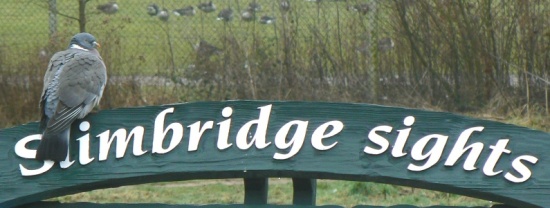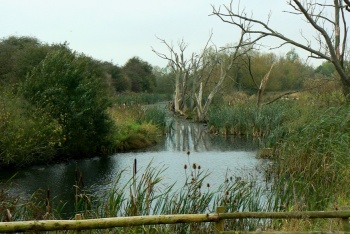| This article is incomplete. This article is missing one or more sections. You can help the BirdForum Opus by expanding it. |
Overview
The Wildfowl and Wetlands Trust (formerly the Wildfowl Trust) was established in 1946 on the banks of the River Severn at Slimbridge in Gloucestershire. For many years this has housed the world's most extensive collection of swans, geese and ducks but Slimbridge also offers visitors the chance to see many wild birds.
The ponds, pens and enclosures housing the captive birds are surrounded by a large area of farmland and saltmarsh known as the Dumbles which attracts huge numbers of wintering waterfowl. In addition there are small reedbeds and dense blackthorn and hawthorn scrub providing cover for migrant passerines.
Birds
Notable Species
The predominant species in winter is the Greater White-fronted Goose, numbers have declined in recent years but they are still nationally significant. Bewick's Swan is another regular wintering species. It now occurs in hundreds attracted by artificial feeding and can be seen on the floodlit Swan Lake. Other wintering waterfowl include Eurasian Wigeon, Gadwall and Common Teal, Northern Shoveler, Common Shelduck, Common Pochard and Tufted Duck.
Rarer waterfowl are frequently recorded at Slimbridge and this is probably the most regular site in Britain for the Lesser White-fronted Goose which occurs among flocks of its larger relative. Snow Goose and Barnacle Goose are regularly seen but thought to originate from the captive collection and Mandarin Duck breeds ferally in the surrounding farmland. Sawbills are regular in small numbers on the estuary in winter and a few Common Scoter can turn up at any time of year.
A variety of waders are attracted to the saltings at Slimbridge during passage periods and in winter. Eurasian Curlew, godwits, Common Redshank and Dunlin are among the most numerous but around twenty species can be seen. Water Rail is resident and can be seen with patience and luck.
Common Kingfisher breed regularly here and can be seen easily from the Kingfisher Hide.
The large concentrations of birds at Slimbridge are bound to attract predatory species and Hen Harrier, Eurasian Sparrowhawk, Merlin and Peregrine Falcon are regular in winter with Northern Hobby a frequent visitor in summer. Short-eared Owl is usually present in autumn and winter and Western Barn Owl is resident.
Rarities
White tailed lapwing, lesser white fronted goose was previously a regular winter visitor. In addition there is the possibility of rarities and there have been occasional records of North American vagrant waders and gulls.
Check-list
Birds you can see here include:
Great Cormorant, Grey Heron, Mute Swan, Bewick's Swan, Whooper Swan, Greater White-fronted Goose, Greylag Goose, Canada Goose, Barnacle Goose, Common Shelduck, Mandarin Duck, Eurasian Wigeon, Gadwall, Common Teal, Mallard, Northern Pintail, Garganey, Northern Shoveler, Common Pochard, Tufted Duck, Common Scoter, Red-breasted Merganser, Goosander, Western Marsh Harrier, Hen Harrier, Eurasian Sparrowhawk, Common Kestrel, Merlin, Northern Hobby, Peregrine Falcon, Water Rail, Common Moorhen, Eurasian Coot, Little Ringed Plover, Ringed Plover, Eurasian Golden Plover, Grey Plover, Northern Lapwing, Red Knot, Sanderling, Little Stint, Curlew Sandpiper, Dunlin, Ruff, Jack Snipe, Common Snipe, Black-tailed Godwit, Bar-tailed Godwit, Whimbrel, Eurasian Curlew, Spotted Redshank, Common Redshank, Common Greenshank, Green Sandpiper, Wood Sandpiper, Common Sandpiper, Ruddy Turnstone, Little Gull, Black-headed Gull, Common Gull, Yellow-legged Gull, European Herring Gull, Great Black-backed Gull, Common Tern, Arctic Tern, Black Tern, Eurasian Collared Dove, Western Barn Owl, Little Owl, Short-eared Owl, Common Kingfisher, Eurasian Skylark, Meadow Pipit, Rock Pipit, Yellow Wagtail, White Wagtail, Pied Wagtail, Common Wren, Dunnock, Eurasian Robin, Black Redstart, Common Redstart, Whinchat, European Stonechat, Northern Wheatear, Eurasian Blackbird, Fieldfare, Song Thrush, Redwing, Sedge Warbler, Common Reed Warbler, Lesser Whitethroat, Common Whitethroat, Blackcap, Common Chiffchaff, Willow Warbler, Spotted Flycatcher, Common Treecreeper, Common Magpie, Carrion Crow, Common Starling, House Sparrow, Eurasian Tree Sparrow, Chaffinch, European Greenfinch, Eurasian Siskin, European Goldfinch, Lesser Redpoll, Lapland Bunting, Reed Bunting
Other Wildlife
In the summer dragonflies and damselflies are numerous, hairy dragonfly and scarce chaser amongst the rarer ones. Mammals include otter, water vole, field and bank vole, and fox (porpoise and seals have been seen after extreme tides). Grass snake is increasing.
Site Information
October to April is the best time to visit Slimbridge with peak waterfowl numbers in January.
Access and Facilities
To reach Slimbridge take exit 13 from the M5, head south on the A38 and follow signs to Slimbridge village and the WWT refuge.
An ideal family destination with shop and education centre, toilet facilities and restaurant. Hides and observation towers overlook the best areas for wild birds.
There is an entrance fee for non-members and the Trust is open 9.30 am to 5.00pm daily.
Contact Details
Slimbridge Wildfowl and Wetlands Trust
Dursley
Gloucestershire
GL2 7BT
Tel: 0871 716 2318
External Links
Content and images originally posted by Steve
Reviews
ajkwba's review
Slimbridge has several hides and you will see a range of birds. In the spring through to Autumn they run a land rover safari where you go 'off limits' with one of the wardens and this is well worth booking.
Also have cafe and shop on site Pros
- Lots of variety
- excellent Land rover safari
Cons
- Pricey if non member
Malcolm Stewart's review
Had my 3rd. and probably best visit to Slimbridge a few days ago. Previous visits were about 30 and 10 years ago. (I've now got the camera gear to do my visits justice.)
The restaurant, shop, gallery were all fine, and we took our meal overlooking one of the flamingo ponds. Pity that the "In Focus" binocular shop was temporarily closed when we passed it, as we then spent so much time in the hides etc. that it was closed when we left by the late leaver's exit.
One of the best features is that one can see, and photograph, wildfowl, and other groups, which whilst fairly common in the UK wouldn't normally allow a close approach. In addition, of course, there's the collections of more exotic species from around the world. One of the highlights on this last visit was to see, and photograph, a kingfisher from the hide (H7) facing the bank where they have their nest holes.
Pros
- Masses of birds
Cons none





